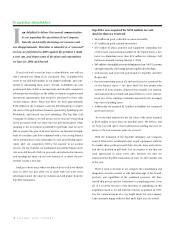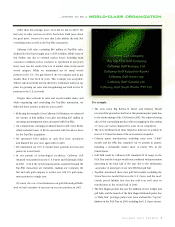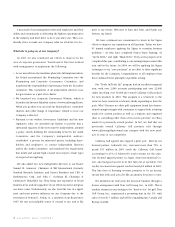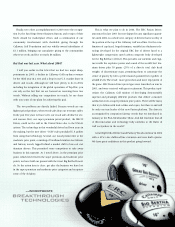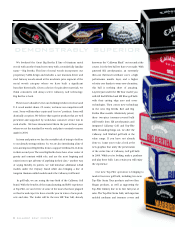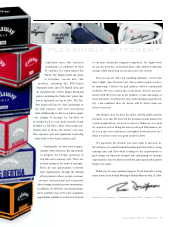Callaway 2003 Annual Report Download - page 15
Download and view the complete annual report
Please find page 15 of the 2003 Callaway annual report below. You can navigate through the pages in the report by either clicking on the pages listed below, or by using the keyword search tool below to find specific information within the annual report.
12 CALLAWAY GOLF COMPANY
management based upon historical bad debts, current customer
receivable balances, age of customer receivable balances, the
customer’s financial condition and current economic trends. If
the actual uncollected amounts significantly exceed the
estimated allowance, then the Company’s operating results
would be significantly adversely affected.
Inventories
Inventories are stated at the lower of cost or market. Cost is
determined using the first-in, first-out (FIFO) method. The
inventory balance, which includes material, labor and manu-
facturing overhead costs, is recorded net of an estimated
allowance for obsolete or unmarketable inventory. The
esti
mated allowance for obsolete or unmarketable inventory is
based upon management’s understanding of market conditions
and forecasts of future product demand. If the actual amount
of obsolete or unmarketable inventory significantly exceeds the
estimated allowance, the Company’s cost of sales, gross profit
and net income would be significantly adversely affected.
Long-Lived Assets
In the normal course of business, the Company acquires tangible
and intangible assets. The Company periodically evaluates the
recoverability of the carrying amount of its long-lived assets
(including property, plant and equipment, goodwill and other
intangible assets) whenever events or changes in circumstances
indicate that the carrying amount of an asset may not be fully
recoverable. An impairment is assessed when the undiscounted
future cash flows estimated to be derived from an asset are less
than its carrying amount. Impairments are recognized in oper-
ating earnings. The Company uses its best judgment based on
the most current facts and circumstances surrounding its business
when applying these impairment rules to determine the timing
of the impairment test, the undiscounted cash flows used to
assess impairments, and the fair value of a potentially impaired
asset. Changes in assumptions used could have a significant
impact on the Company’s assessment of recoverability.
Numerous factors, including changes in the Company’s business,
industry segment, and global economy, could significantly
impact management’s decision to retain, dispose of, or idle
certain of its long-lived assets. For example, during the fourth
quarter of 2003, following the Top-Flite acquisition, the
Company began consolidating the Callaway Golf and Top-Flite
golf ball and golf club manufacturing and research and devel-
opment operations. In connection with this consolidation, the
Company disposed of certain of its long-lived assets. As a result,
the Company reduced the carrying value of its golf ball assets
and therefore incurred pre-tax charges to earnings in the
amount of $24.1 million, which were primarily non-cash. See
below “Top-Flite Acquisition.”
During the third quarter of 2003, the Company evaluated and
determined that the undiscounted future cash flows estimated
to be derived from its golf ball assets, including the acquired
Top-Flite golf ball assets, exceeded the carrying value of such
assets and therefore no impairment existed. As noted above,
during the fourth quarter of 2003, the Company disposed of
certain of its long-lived assets which reduced the carrying value
of its golf ball assets. At that time the Company determined that
no impairment existed. If the Company were to change the
manner in which it conducts its golf ball business or otherwise
lower its estimates of the undiscounted cash flows it expects to
derive from its golf ball assets, the Company could be required
to assess impairment again.
Warranty
The Company has a stated two-year warranty policy for its
Callaway Golf clubs, although the Company’s historical practice
has been to honor warranty claims well after the two-year stated
warranty period. The Company’s policy is to accrue the esti-
mated cost of satisfying future warranty claims at the time the
sale is recorded. In estimating its future warranty obliga
tions,
the Company considers various relevant factors, including
the
Company’s stated warranty policies and practices, the histor-
ical frequency of claims, and the cost to replace or repair its
products under warranty. If the number of actual warranty
claims or the cost of satisfying warranty claims significantly
exceeds the estimated warranty reserve, the Company’s cost
of sales, gross profit and net income would be significantly
adversely affected.


